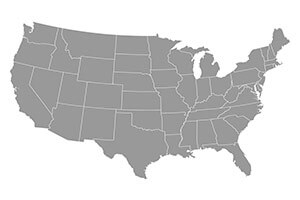
UNITED STATES
Honey crops will be down in the United States this season due to drought conditions suffered in the big honey-producing states of Florida, South Dakota, North Dakota and Montana. There have been some bright spots, however, such as the resurgence of honey production in California after that state’s long drought finally ended. In addition, some states in the Northeast, East Central and West Central areas also had better honey production this season. Wholesale honey prices, especially for the lighter grades, have increased. Lighter honey inventories are down, so beekeepers believe packers will be more aggressive in their buying this fall and winter, especially in view of the expected smaller U.S. honey crop.
On July 27, 2017 the USDA expanded crop insurance for beekeeper operations to include 19 additional states and now spans the entire 48 contiguous states. The USDA Risk Management agency also announced changes to the Apiculture Pilot Insurance (API) plan, ensuring greater protection for the producers’ honey, pollen collection, wax and breeding stock. Producers have until Nov. 15, 2017 to enroll in API coverage for the 2018 crop year. Crop insurance is sold and delivered solely through private crop insurance agents. A list of agents is available at all USDA Service Centers.
NORTHEAST
Many beekeepers in the Northeast blamed cool, wet spring weather for hurting traditional flows from black locust, sumac, autumn olive, tulip poplar, honeysuckle, early clover and assorted wildflowers. Later berry flows were better, as well as later clover and basswood flows. Now that beekeepers were having warmer summer temperatures they were hoping for better summer and early fall flows from assorted wildflowers including goldenrod, aster, knotweed and knapweed. Pollinators had moved their colonies from blueberries, apples and other fruit trees to cranberries. Earlier in the season some of our reporters indicated problems with heavy swarming. Demand and pricing for honey in this area remains excellent, but little new crop honey has been marketed yet this year.
MIDEAST
Weather-related problems are blamed for a downturn in honey crop yield over much of this area. While beekeepers in parts of North Carolina, Kentucky and West Virginia often blamed cool, wet spring weather for poorer honey crops, beekeepers in parts of Virginia blamed dry weather. Some of the biggest flow disappointments mentioned included black locust, wildflowers, basswood, thistle, and clover. On the other hand, reporters in other locations said their best flows came from tulip-poplar, black locust, autumn olive and clover. Sourwood flows in the mountains came earlier than normal this season and some beekeepers were caught off guard. Beekeepers were still hoping for later flows in areas with sufficient moisture from goldenrod, aster, knotweed, knapweed and other late-blooming sources. Despite poorer crops, beekeepers were anxious to extract this season’s crop since they have had so many inquiries from customers about new crop honey. Then, too, many late summer and fall festivals and farmer’s markets are starting. These always provide a ready market for new crop local honey.
SOUTHEAST
After suffering all spring under drought conditions, Florida beekeepers report heavy rainfall in June which will improve later flow prospects from goldenrod, aster, Brazilian pepper and melaleuca. Unfortunately, traditional spring flows from citrus, tupelo, gallberry and palmetto were all down in the state as a whole. One unfortunate side effect of the heavy June rains was some reports of colony starvation. Total honey production was also down in Georgia, Mississippi and parts of Alabama. Beekeepers said their flows from clover, privet, crepe myrtle and mimosa were just fair to poor. Some beekeepers in the mountains produced fair to good sourwood flows, and in Mississippi clover flows were better than normal for parts of the state. Beekeepers in Florida were also reporting some spotty flows from tallow and mangrove. Many of the Florida colonies are still out of state for honey flows or pollination contracts. Beekeepers are starting treatments for mites, as well as being vigilant for small hive beetle outbreaks.
Beekeepers are still worried about the wholesale honey market, especially in view of continued price competition from cheaper foreign honey imports. Prices being paid on lighter colored gallberry, citrus and clover honey were better, however. Retail honey sales continue to be generally good over most of this area. Area farmers’ markets, fairs and festivals are helping with sales of new crop honey.
SOUTHWEST
After finishing the main spring flows, some beekeepers were forced to feed colonies in order to nurse them through the dry, dearth period. In some parts of the area, periodic rains had kept more wildflowers in bloom than normal for this time of year. In addition, irrigated alfalfa and cotton are starting to provide honey flows in some area states. Beekeepers said some of their best flows came from earlier wildflower and brush flows. Tallow and privet hedge were also mentioned as providing surplus honey, although the privet hedge flow was down from normal. Soybeans and scattered clover were also providing late flows in parts of Arkansas and Louisiana. Periodic rains had helped to keep plants from drying up as soon as they normally do in some parts of the Southwest.
Over 50% of this season’s honey crop had been extracted and beekeepers were now dickering with buyers at the wholesale level on new crop honey prices. Beekeepers were reporting good retail honey sales at regional fairs, festivals and farmers’ markets.
EAST CENTRAL
Spring honey crops in Illinois and Indiana were better than normal with some beekeepers producing excellent honey crops. Later dry weather was a concern, but some of these locations did receive good later rains, so this may help later summer and early fall flows from soybeans, goldenrod, aster and Spanish needles. Farther north, however, beekeepers in Michigan, Wisconsin and parts of Ohio said their crops were delayed by …


